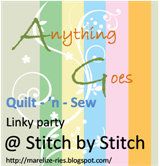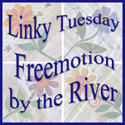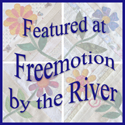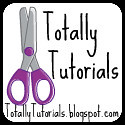A week of QAYG quilting on
hosted by Amy @the cute life
This week I have wrapped up all the Quilt As You Go (QAYG) quilting on the 9 blocks and added a 10th Selvedge block to finish my layout.
Block 10 - Selvedge Block
I've wanted to try a Selvedge Block for ages so this seemed like a great opportunity to learn another technique and round the number of blocks up to 10 which would make the final layout easier. This is quite appealing as it's now a QAYG quilt so I've decided to opt for a simple grid layout while I'm learning my new QAYG skills.
To make this selvedge block I spray basted the backing sheet to the batting and then sprayed more basting spray onto the top of the batting. I then started laying my selvedge strips from the fabrics used in making this quilt onto the batting overlapping a finished edge over each raw edge. The strips held firmly in place, thanks to the basting spray (my new favourite tool!) and then I quilted along the selvedges with very closely spaced lines making sure to catch down all the selvedge edges.
I loooovvve this block, I'm so glad I tried it and I love too that it records all the fabrics used in the quilt which is really neat.
QAYG Details for Blocks 1, 2, 3, 4, 5 & 8
(not necessarily in that order as I'm sick of fighting with html code each time I try to move things around!!!)
Block 1 - Bargello
Block 4 - Reverse Applique
You know I was so unsure about this block but I decided to do echo quilting around each reverse applique opening and in the end I've decided to keep it the final quilt layout.
Block 5 - Sashiko
Block 2 - Scraptastic
Block 8 - Pinless Curves
Block 3 - Folded Block
and here's my plan for the final QAYG layout

and this is how the back will look
I just can't 'relax' into free motion quilting (FMQ) - I've followed all tips and advice, drinking a glass of wine, drinking two glasses of wine, drinking a bottle of wine, listening to great music. I've got an adjustable Tempur-Pedic chair and a Sew Ezi sewing table so my machine bed is level with my working surface, I have a Supreme Slider mat and a Quilt Halo ring. Sometimes I use my Bernina BSR on settings 1 and also 2 and sometimes I use my darning foot with the stitch set to 0 and the feed dogs down and then again sometimes with the feed dogs up (to keep the tension working) and the Supreme Slider in place. The only thing I don't seem to be able to change is ME - I just can't relax while I'm fmqing and I've paid the price this weekend for all my work - I've got a frozen neck and shoulder so I couldn't sew yesterday and, although it's loosening a bit now, I think I should leave it alone today as well.
Need a trip to my LQS today though to pick up some fabric to sash and bind the quilt. Quite nervous about this next stage - I've read lots of great tutorials but just want to get on with trying it for myself now.
I'll be back with a finished quilt for you as soon as my neck and shoulder will let me!!!
You can follow The Something NEW Sampler on flickr
Featured On:
Linking To:






Featured On:
Related Posts:
A Modern Bargello
Scraptastic & Folded Blocks - The Something New Sampler: Week 2
Reverse Applique & Sashiko Blocks -The Something New Sampler: Week 3
Trapunto & Pinless Curve Blocks - The Something NEW Sampler: Week 4
Machine Applique and Cathedral Windows Blocks - The Something NEW Sampler: Week 5
Scraptastic & Folded Blocks - The Something New Sampler: Week 2
Reverse Applique & Sashiko Blocks -The Something New Sampler: Week 3
Trapunto & Pinless Curve Blocks - The Something NEW Sampler: Week 4
Machine Applique and Cathedral Windows Blocks - The Something NEW Sampler: Week 5
Linking To:










































































